The newly released Central Corridor Tracker and Big Picture Project reports, measure the impact of light rail on neighborhoods along University Avenue between downtown Minneapolis and downtown Saint Paul.
former Compass researcher Ellen Mai, who managed the data analysis for the projects, reflects on the latest outcomes and shares key takeaways.
1. Between 2010 through 2013, more than 3,500 new housing units were added along the Corridor
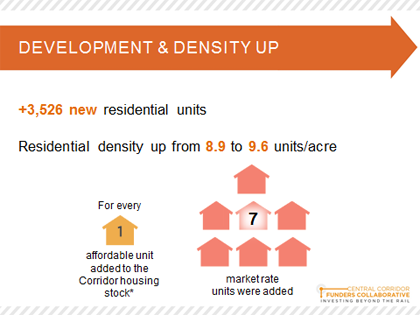
Much of the new housing development is concentrated in the high-density areas of the two downtowns and the University of Minnesota. While development throughout the Midway neighborhoods has been slower, progress has been made, including the 174-unit Episcopal Homes senior housing project on University Avenue, located between Prior and Fairview Avenues. What’s more, we know through our Big Picture Project work that a number of multifamily projects came online in 2014, with more in store for 2015.
2. The number and proportion of affordable housing units along the Corridor is increasing.
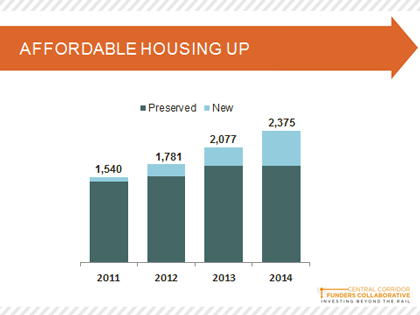
One of the objectives of the Central Corridor Funders Collaborative has been to ensure that residents at all income levels can afford to live along the Corridor, amidst investment in light rail and associated development projects that could potentially drive up housing costs in surrounding neighborhoods. Proactively, the Collaborative funded the creation of Affordable Housing working group to not only monitor change in housing costs and stock over the light rail development period, but also to develop an overall affordable housing strategy and plan.
Not only has the share of low-income households earning less than $30,000 remained stable since Baseline (~44%), there have also been more affordable housing units produced. In 2014, nearly 300 new and subsidized housing units were added to the Corridor housing stock, almost doubling the prior three years’ combined new unit count, from 338 to 637 units. Progress is attributed to three sizable, multi-family housing projects: Old home/Western University Plaza, Hamline Station and Five15 on the Park. While most new units remain market-rate, 12 percent of units built between 2011 through 2014 are affordable for low-income residents, a notable improvement of 5 percentage points over the three previous years. These new units, added to the 1,738 preserved affordable units, result in a total unit count just shy of the affordable housing working group's baseline goal of 2,540 units by 2020.
3. New focus on the importance of parks and open space
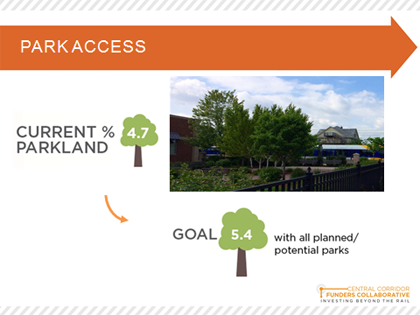
Grounded in the idea that green space impacts overall quality of life and enhances community investment on the part of residents and businesses alike, several benchmarks around parkland were created by the Green Line Parks and Commons group to encourage growth in the space devoted to parks and POPS (privately owned, public spaces along the corridor). While the larger Twin Cities metro area is often noted for its well-developed parks system, open space is not distributed evenly across the region, with noted room for improvement along the corridor. In 2014, just under 5 percent of the corridor’s acreage was dedicated to parks and commons, less than a third of the comparable share for the cities of Minneapolis and St. Paul. Outside of the Twin Cities, no other city has yet to develop goals or metrics for the amount of parkland in a transit corridor.
4. Rail ridership is exceptionally strong out of the gate
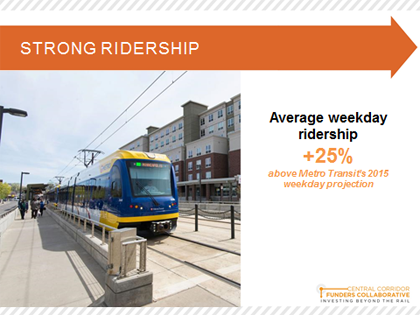
Now that the train is operational, we were able to roll several ridership metrics into the fold. In the first partial year of operation, the line’s average weekday ridership of 34,548 reported by Metro Transit was approximately 25 percent higher than their 2015 projection. Even more impressive, combined transit ridership on routes serving Corridor neighborhoods – the Green Line, local bus route 16, and express route 94 – nearly doubled last year’s ridership on comparable routes, and contributed to the highest ridership in the seven-county region since 1981 (84.5 million trips).
5. Corridor stakeholders see need to sustain momentum and progress
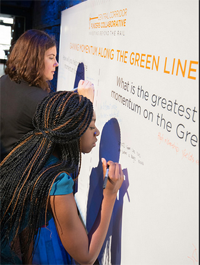
With the light rail now operational, the focus has shifted from getting ready for rail to sustaining the work that has been done, ensuring that the corridor is a place for residents to live, work and play for years to come. Through our annual stakeholder survey, corridor stakeholders shared their perception that goals towards common equitable development are in place, but emphasized the need for sustaining current momentum and continued progress.
For myself and on behalf of Wilder Research, I would like to express gratitude for being a part of this unique, place-based analysis tracking longitudinal change with an eye towards equitable development, hopeful that the body of work can serve as a model for other communities undergoing momentous change.
Ellen Mai is a former research associate with Minnesota Compass.
Related
Business Resources Collaborative releases 2015 report on the state of Green Line businesses